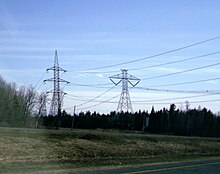HVDC Québec – New England
The HVDC Quebec – New England is a high voltage direct current transmission line from Radisson , Québec to Sandy Pond in Ayer , Massachusetts . In contrast to most other HVDC systems, it is a multipoint connection. It originally consisted of the 172 km long section between Des Cantons in Québec and Comerford Reservoir , New Hampshire , which had to be implemented as HVDC due to the asynchronous operation of both power grids. This line went into operation in 1986 and was able to transmit a maximum output of 690 MW. The bipolar operating voltage is ± 450 kV.
It was planned to extend the line beyond the endpoints at Des Cantons and Comerford to carry power from the hydroelectric plants at La Grande in the Baie-James region to the Boston area. For this reason, the line was extended 1,100 km north to the Radisson converter station and south to the Sandy Pond converter station in Massachusetts. The transmission capacity was increased to 2 GW by expanding the converter stations. The operating voltage remained unchanged at ± 450 kV. To connect the area around Montreal , a further converter station was built at Nicolet in 1992 with a transmission capacity of 2 GW.
Crossing the St. Lawrence River
The crossing of the St. Lawrence River is noteworthy as it was initially designed as an overhead line crossing and was later replaced by a cable tunnel. This unusual procedure was used because timely commissioning was only possible with an overhead line crossing, but there was also fear that the overhead line crossing would not be accepted by the population of Grondines and Lotbinière .
In 1988, construction began on three artificial islands in the St. Lawrence River, which were provided with dams to the mainland, as a construction site for the masts of the overhead line crossing. Between July 1988 and spring 1989, 20,000 truck loads with a total amount of 400,000 tons were transported for this purpose. In 1989 the five masts of the overhead line crossing were erected, which took a total of five months. The two masts on each side of the fairway were 140 m high to ensure the required clearance. The erection of these masts took five months. The overhead line crossing was completed at the end of 1989.
In the spring of 1989, work began on the 3954 meter long cable tunnel. The average rate of advance was 27 m per day. On March 26, 1990, the tunnel boring machine reached the surface, 8 cm from its target point. Later the tunnel was clad with concrete and channels for the cables were installed. On November 1, 1990, the line went into operation with a transmission capacity of 1.2 GW, which was increased to 2.25 GW on July 1, 1991. In 1992, the overhead line crossing including the dams and the artificial islands were dismantled. One of the masts was used to build the lookout tower of the Cite de l'Energie. The cost of mining was 16 million Canadian dollars.
Coordinates
- End point Radisson, Quebec: 53 ° 43 ′ 30 ″ N , 77 ° 44 ′ 13 ″ W
- North end of the cable tunnel under the St. Lawrence River: 46 ° 37 ′ 32 ″ N , 72 ° 0 ′ 51 ″ W
- Endpoint Sandy Pond in Ayer, Massachusetts: 42 ° 34 ′ 13 ″ N , 71 ° 31 ′ 27 ″ W
- Further use of one of the high-voltage pylons as a lookout tower in a theme park in Shawinigan , Québec 46 ° 32 ′ 11.9 ″ N , 72 ° 45 ′ 28.1 ″ W

